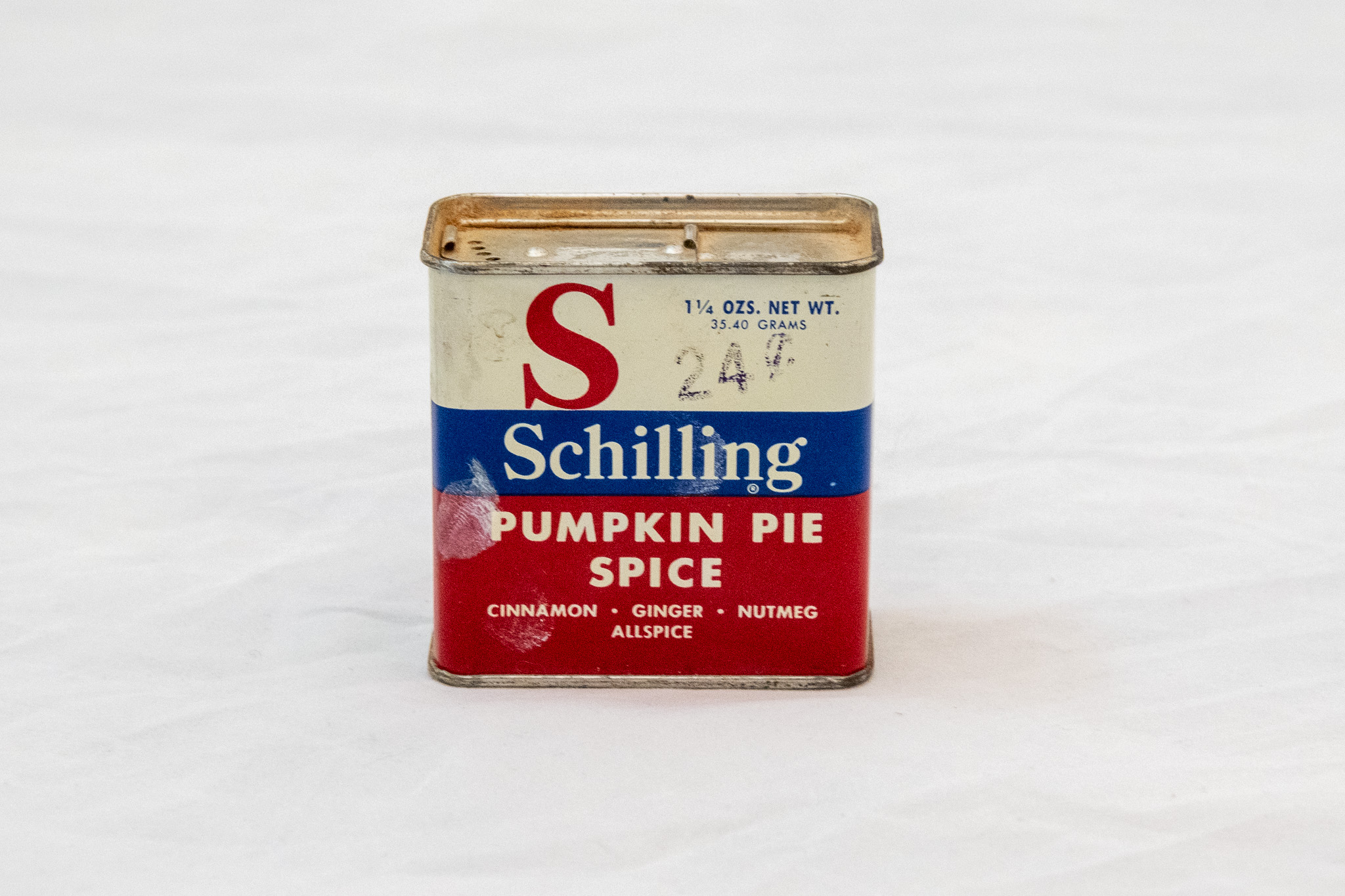A conversation with the Moab Museum
When I first asked Mary Langworthy, public programs manager at the Moab Museum, about putting together a special Thanksgiving edition of the Moab Sun News, I pictured photographs of grim-faced pioneers over a heaping table of turkey and mashed potatoes.
But the only thing we could find in the Museum’s collection was a tin of Schilling pumpkin pie spice once owned by Louise Watts. Watts was a longtime Moabite and teacher who died in 1981; her items were gifted to the museum in 1982. On the back of the tin is a small and simple recipe for pumpkin pie: combine prepared pumpkin, salt, molasses, brown sugar, and pumpkin pie spice, add eggs and milk, pour into an unbaked pie shell. The spice itself was made up of cinnamon, ginger, nutmeg, and allspice.

Langworthy and I thought: why can’t we find anything else? We thought: how do we remember tradition?
In the weeks leading up to Thanksgiving, and especially on Thanksgiving Day, my family will listen to the musical “Joseph and the Amazing Technicolor Dreamcoat” (by the Original Broadway Cast, 1982). This is probably because of some miscommunication down the line—there must’ve been a moment of, “wait, Joseph isn’t a holiday musical?”—but by then, it was too late. It’s a habit my family refuses to break, an ingrained tradition. But it’s also a tradition that would be impossible to capture in a thing, like a photo; it can’t be put into a physical box. It doesn’t make much sense as an oral history, either: “We listen to a musical every Thanksgiving, and no one knows why, or who started it, but I do know all of the words to all 16 songs.” It’s this small and goofy tradition we keep close, for fear of embarrassment, maybe, but more likely for the intimacy of sharing something with only people who get it.
I asked Stephan Zacharias, former history programs interpreter at the Moab Museum, about local traditional Thanksgiving recipes, but he said he never found anything very old. The only leads he had were from the Grand Center’s “Grand Recipes” book (available at the Grand Center for $10!) and the Moab Ladies Auxiliary recipe book published in the 1990s. Communities sometimes have fundraising cookbooks from pre-World War I, Zacharias said, especially in places with strong church communities. But here, he found no record of such a book.
When the tin of pumpkin spice was officially accessioned—brought into the Museum Collection—in 1982, it was part of a collection of many other home items like children’s rocking chairs, dolls, hair clippers, and spices (including paprika and curry powder). The museum used the items to create a replica of a kitchen, which was on display for a few years.
Many kitchens today probably look alike to Watts’s kitchen. Maybe that’s the missing link in remembering Thanksgiving in tangible things: the pumpkin pie recipe on the back of Watts’s spice tin is similar to the same recipe we use today. Maybe Moabites pull out the same printed paper, with the same recipe grandma used, every Thanksgiving. Why put those things in a museum if you don’t think they’ll change?
Or maybe there’s not much to Thanksgiving worth remembering. According to the Smithsonian, the first Thanksgiving service may have happened as early as 1578; the famous pilgrims’ Thanksgiving feast was held in 1621. We know too that the idea of the pilgrims and Wampanoag people having a great feast when the pilgrims arrived is false; David Silverman, author of “This Land is Their Land: The Wampanoag Indians, Plymouth Colony, and the Troubled History of Thanksgiving,” told Smithsonian Magazine in 2019 that “the Thanksgiving myth doesn’t address the deterioration of this relationship culminating in one of the most horrific colonial-Indian wars on record.”
In 1863, following Sarah Josepha Hale’s push to create a Thanksgiving holiday (Hale was the editor of Ladies Magazine and Godey’s Lady’s Book), President Abraham Lincoln proclaimed that a national Thanksgiving Day be observed every year on the fourth Thursday of November.
The menu hasn’t changed much—Americans still typically enjoy a turkey, pies, and mashed potatoes on the holiday. It’s a sometimes less-than-thrilling menu: in her bestselling cookbook “Salt, Fat, Acid, Heat,” Samin Nosrat, who first celebrated in college, wrote: “I loved the hubbub involved in preparing and gathering for the meal, but the actual eating part of Thanksgiving was kind of a letdown … I really love to eat, but these soft, rich, bland foods bored my palate after just a few bites.”
I think it’s the tradition of spending a day with friends and family that keeps us all coming back to it, less so the historic tradition of eating too much food in celebration of colonialism. Thanksgiving traditions are intangible: they’re found in the small reflections of what we’re thankful for, the day spent bustling around the kitchen with friends, the background tune of “Joseph and the Amazing Technicolor Dreamcoat” (just me?). But this year, after realizing I wanted to see those old memories of Moab Thanksgivings, I’m going to take more photos.
Have a passed-down Thanksgiving recipe? Took a Thanksgiving family photo? Email them to me and we’ll publish them: alison@moabsunnews.com.
______________
Read the rest of this week’s edition:
Arches timed entry will continue in 2024
Cultivating community during Women’s Wall Street Wednesdays
Trail Ambassador program receives LNT Gold Standard Designation
Cranksgiving only comes once a year
City parks master plan moves forward
Meeting at a glance: Moab City Council, November 14, 2023
Opinion: Letter to the Editor—”Don’t let the Beaver Shaft uranium mine reopen in La Sal”
Moab History: Sufferage in Utah
Or, read through a pdf of this week’s print edition



